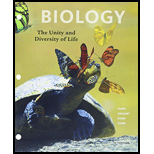
Concept explainers
New World monkeys _____.
- a. lack a tail
- b. are bipedal
- c. live only in Africa
- d. are dry-nosed primates
- e. are human ancestors
- f. all of the above
Concept introduction: The most advanced placental mammals are the primates. The primates are the only group of mammals that can extensively use their forelimbs for purposes other than locomotion. The primates have two suborders: Strepsirrhini and Haplorhini.
Answer to Problem 1SQ
Correct answer: New World monkeys are dry-nosed primates. Hence, the correct answer is option d.
Explanation of Solution
Reason for the correct answer:
During the early divergence of primates, they had two distinct lineages that include the wet-nosed primates (Strepsirrhini ) and the dry-nosed primates (Haplorhini). The dry-nosed primates include modern primates such as humans and monkeys. Refer Fig.26.2 “Proposed evolutionary tree for modern primates”, in the text. The lineage tree clearly shows that New World monkeys are Anthropoids that are diverged as dry-nosed primate from an early primitive ancestor.
Option d. is given as “are dry-nosed primates”. Since dry-nosed primates also include New World monkeys, the correct answer is option d.
Reason for the incorrect answers:
Option a. is given as “lack a tail”. New World monkeys do have a tail. Hence, option a. is incorrect.
Option b. is given as “are bipedal”. New World monkeys are not bipedal. Only humans are the primates that are bipedal. Hence, option b. is incorrect.
Option c. is given as “live only in Africa”. New World monkeys inhabit South America. Hence, option c. is incorrect.
Option e. is given as “are human ancestors”. The ancestors to humans are apes. Hence, option e. is incorrect.
Option f. is given as “all of the above”. New World monkeys are dry-nosed primates and none of the other options describes them. Therefore, the option cannot be 'all of the above'. Hence, option f. is incorrect.
Hence, options a., b., c., e., and f. are incorrect.
Want to see more full solutions like this?
Chapter 26 Solutions
Bundle: Biology: The Unity and Diversity of Life, Loose-leaf Version, 14th + MindTap Biology, 2 terms (12 months) Printed Access Card
- Why is it interesting that Homo luzonensis was found on an island? A. The islands only formed after Homo luzonensis became extinct, so Neanderthals must have put them on the island B. The islands were a few miles apart, and Homo luzonensis would have needed to either float by grabbing on a tree or make a raft C. The islands were a few miles apart, and Homo luzonensis clearly had to learn how to fly to get to them D. The islands were volcanoes when Homo luzonensis was alive, so it's unexpected that they were therearrow_forwardWhich of the following statements about the hominoids is false?a. Hominoids include gorillas, chimpanzees, and humans.b. Hominoids have larger brains than other primates.c. Hominoids lack tails.d. Hominoids typically are bipedal and walk uprightarrow_forwardWhich of the following is NOT an ancestral trait in primates? A. Trichromacy B. Having Nocturnal Adaptations C. Fur D. Clawsarrow_forward
- Can you answer my questions. Lucy's relatives probably lived in an environment consisting of A. riverine forests and lake margins B. dry/hot desert conditions C. high tundra, grassland-areas D. savanna grasslands Which of the following is NOT one of the proposed hypotheses for the evolution of bipedalism? A. The need for a more efficient mode of locomotion B. The need to reach fruit and leaves on taller bushes C. The need to have free hands for carrying offspring and tool use D. The need to express symbolic meaning through cave painting The Great Rift Valley in Africa A. is a fossil-rich, geographic area that extends from Ethiopia to Tanzania B. has produced the most Neanderthal fossils to date C. has not produced any hominid fossils. D.arrow_forwardWhich of the following does not distinguish humans from other primates? a. We are the only primates that use tools. b. We live a long time, including well past our reproductive years (past menopause). c. We manipulate resources on a scale that is not matched by any other animal, primate or otherwise. d. We are bipedal, with non-prehensile feet.arrow_forwardWhich of the following is not an anthropoid? a. Lemurs b. Monkeys c. Apes d. Humansarrow_forward
- Which of the following is NOT a trait commonly found in primates? A. Nails on the fingers and toes B. Color vision that includes reds and yellows C. Having a prehensile tail D. Skeletal anatomy that protects the eyesarrow_forwardWhich of the following best reflects a phylogenetic relationship between chimpanzees and baboons? A. They are grouped together because they live in similar habitats. B. They are grouped together because they have a common ancestor in recent history. C. They are grouped together because they both have an opposable thumb. D. They are grouped together because they both feed their young breast milk.arrow_forwardAfter the mass extinction that occurred 65 million years ago, mammals rapidly diversified to occupy habitats that were previously unavailable to them. What concept does this illustrate? A. Adaptive radiation B. Cretaceous selection C. Reproductive isolationD. Heterozygote advantagearrow_forward
- Whale skeletons contain nonfunctional pelvic bonesa. as a result of convergent evolution.b. due to catastrophism.c. because whales evolved from ancestors that had hind legs.d. because the bones might be needed for a future adaptation.arrow_forwardScientists collectively call humans and their immediate ancestors (a) mammals (b) primates (c) anthropoids (d) hominoids (e) homininsarrow_forwardWhich of the following is not a change that occurred through primate evolution? a size of teeth b change in DNA c location of spinal cord entering skull d size of brainarrow_forward
 Biology (MindTap Course List)BiologyISBN:9781337392938Author:Eldra Solomon, Charles Martin, Diana W. Martin, Linda R. BergPublisher:Cengage Learning
Biology (MindTap Course List)BiologyISBN:9781337392938Author:Eldra Solomon, Charles Martin, Diana W. Martin, Linda R. BergPublisher:Cengage Learning Biology: The Unity and Diversity of Life (MindTap...BiologyISBN:9781337408332Author:Cecie Starr, Ralph Taggart, Christine Evers, Lisa StarrPublisher:Cengage Learning
Biology: The Unity and Diversity of Life (MindTap...BiologyISBN:9781337408332Author:Cecie Starr, Ralph Taggart, Christine Evers, Lisa StarrPublisher:Cengage Learning

